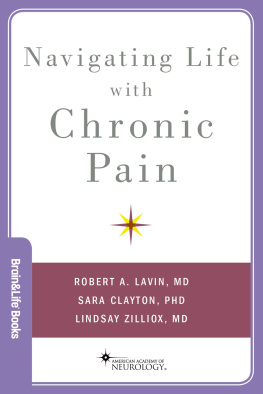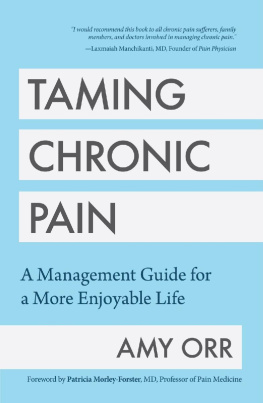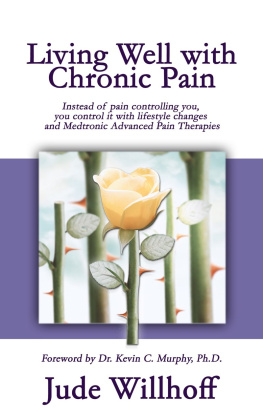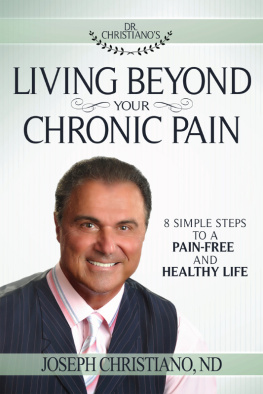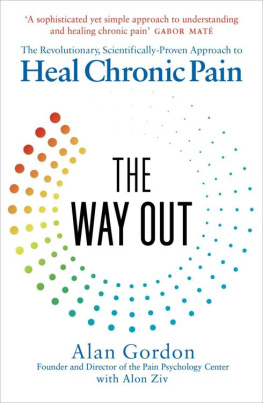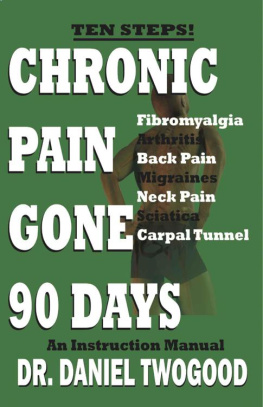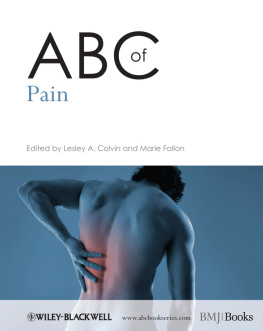CONQUER YOUR CHRONIC PAIN
CONQUER YOUR CHRONIC PAIN
A Life-Changing Drug-Free Approach for Relief, Recovery, and Restoration
PETER ABACI, MD

Copyright 2016 by Peter Abaci
All rights reserved under the Pan-American and International Copyright Conventions. This book may not be reproduced, in whole or in part, in any form or by any means electronic or mechanical, including photocopying, recording, or by any information storage and retrieval system now known or hereafter invented, without written permission from the publisher, The Career Press.
C ONQUER Y OUR C HRONIC P AIN
E DITED BY P ATRICIA K OT
T YPESET BY P ERFEC T YPE , N ASHVILLE , T ENN .
Printed in the U.S.A.
To order this title, please call toll-free 1-800-CAREER-1 (NJ and Canada: 201-848-0310) to order using VISA or MasterCard, or for further information on books from Career Press.

The Career Press, Inc.
12 Parish Drive
Wayne, NJ 07470
www.careerpress.com
www.newpagebooks.com
Library of Congress Cataloging-in-Publication Data
CIP Data Available Upon Request.
For my father, Zeki.
ACKNOWLEDGMENTS
I have been blessed over the years to work with so many compassionate and innovative clinicians at the Bay Area Pain & Wellness Center. Your hard work and huge hearts are a constant inspiration. For most of my career, I have had the good fortune of working side by side with Dr. John Massey, who has a heart of gold and a never-ending passion to heal. Special thanks go to Michael Sullivan, Christine Hirabayashi, Rachel Votaw, Lucrecia Martinez, and Karlee Holden for your valuable ideas and insights.
I am also indebted to the thousands of patients who have invited me into their lives and bestowed their trust upon me. In particular, I would like to recognize Eric Morton and Brandon Anderton for opening up and sharing your brave stories to our readers.
Gratitude also goes out to my agent, Andrea Hurst, for always believing in me and my mission; Barry Fox for your patience with my creative process; Lauren Manoy, Adam Schwartz, Laurie Kelly-Pye, and the rest of the team at Career Press/New Page Books; and to Justin Loeber and the team at Mouth Public Relations.
Lastly, a big hug to my wife, Pamela, and our kids, Anthony and Gabriella, for being so understanding and supportive throughout the whole process.
CONTENTS
INTRODUCTION
What Makes the Doctor Feel Good
C an you imagine being able to walk into a room and have the power to do something that will make somebodys pain go away?
Being able to change the way a person feels for the better, and in just a matter of minutes, is an exhilarating feeling for a doctor. A patient comes to you with debilitating pain in his or her back, leg, or neck, and you have the ability to perform a procedure or deliver a medication that quickly dissipates that persons pain. Back when I was starting off as a doctor in training, that was my idea of a rush. What a major league baseball player feels after hitting a game-winning home run, or a concert pianist after opening night, that was what I felt after treating a patients pain.
While in medical school at the University of Southern California (USC), I became good friends with a bright, happy-go-lucky classmate named Jack. During downtime from class, we often played pickup basketball games with the guys, went to Trojan football games on weekends, lifted weights together, and mostly kept each other laughing through the stress of medical school. Back then I was undecided about which field of medicine I wanted to go into, but Jack was sure he wanted to become an anesthesiologist. He seemed to know quite a bit about the specialty, perhaps because his mom worked as an administrator in the anesthesia department at USC. Jack eventually convinced me that a career in anesthesia would be challenging, rewarding, and at the same time, would mean I would only have to deal with any given patients complex medical problems for a finite period of time. The opposite would be true in a career based on chronic disease management. Anesthesia seemed like a great choice.
Jack and I stayed at USC for our anesthesia residencies, which meant we spent a lot of time working and training at Los Angeles County Hospital, one of the largest and busiest hospitals in the country; in many ways, a world unto itself. A major trauma center serving vast numbers of indigent patients from the greater Los Angeles area and beyond, County Hospital was loaded with people suffering from every conceivable disease, including some not usually seen in the United States. Crises were as routine as your morning cup of coffee. Every minute of every day, people with gunshot wounds, stab wounds, fractured skulls, and limbs torn off in motorcycle accidents were rolled or dragged in through the hospital doors. On many Saturday nights, we worked frantically to save people who had been caught up in what we referred to as the knife and gun club. People were born in that hospital, died there, and those without homes sometimes even lived there.
It was exciting to have patients lives literally in my hands all day long, and I soon became determined to make sure that each and every one of them woke up pain-free. The more cases I handled, the better I got at titrating medications so that patients would wake up feeling very comfortable, no matter what type of surgery they had undergone. And by the time I reached my senior year of residency, I very much wanted to apply my pain-relieving skills outside of the operating room. As it happened, there was a brand new specialty associated with anesthesia that dealt with pain management, so that became my senior elective.
During this rotation, I was introduced to painful diseases like diabetic neuropathy, trigeminal neuralgia, complex regional pain syndrome, and herniated discs. I learned how to relieve these terrible, long-standing pain problems by performing special nerve blocks and other high-tech procedures. The results were instantaneous and made me feel great. Lets face it, being able to walk into a room and do something on the spot that wipes away someones pain gives you a god-like feeling! And using cutting-edge technology that few other doctors have mastered made me feel even more special. So once my anesthesia residency was complete, I went to the University of California at San Francisco for a fellowship in pain management.
There, my program director introduced us to a new concept: How about considering the patient as a whole, rather than focusing exclusively on the area where the pain seemed to be originating? This philosophy of medicine, called the biopsychosocial model, is based on the premise that emotions, thoughts, and cultural biases all play integral roles in a persons disease and his or her ability to function in society. And in order to treat a patient effectively, all of these issues must be addressed. For chronic pain, this means understanding how a persons pain influences her emotional state and ability to get through the day, work and interact with others, and more. Then these issues can be addressed as part of a larger problem that includes but is not limited to the pain.
While the biopsychosocial model had been around for decades, during my fellowship the idea of applying it to the treatment of pain was still novel. And there were problems, which still remain today. Academic training centers are notorious for neglecting to provide long-term patient follow-up. Fellows are very busy mastering high-tech procedures and spinal implants, and the proper use of designer medications, so they dont have much time to think about their patients health and well-being over the long term. And even if a fellow does happen to be curious about the long-term effects of the medicines, procedures, and surgeries, she may only see a given patient for a few weeks or months before she moves on or the patient does. So if a fellow prescribes a new medication or injection today, he will never really know how it might affect that patient a year or two down the road. As a result, doctors in pain management are not trained to think in terms of long-term outcomes or the big picture. And neither was I.
Next page

